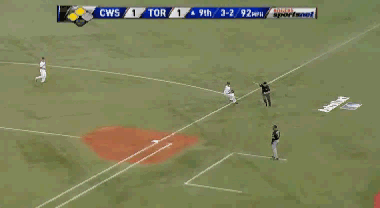Today's Game Of the Day is the first start of the season (and of the Milwaukee Brewers career) for Zack Greinke. Greinke was traded, along with SS Yuneisky Betancourt, from Kansas City to Milwaukee this off season for a solid package of players including SS Alcides Escobar, Lorenzo Cain, Jake Odorizzi, and Jeremy Jeffress.
I wrote about Greinke
here, when I didn't know he was going to pitch in the NL or miss the first month of the season.
Greinke suffered his injury playing pickup basketball so the injury wasn't pitching related. There shouldn't be much reason to expect Greinke to pitch any worse than what we would have thought before the season, just that he'll pitch less.
Greinke made 3 minor league starts to gear up for tonight. They looked like this:
High A: 1 start, 3 innings pitched, 10 batters faced, 1 hit, 0 walks, 4 strike outs.
AAA: 2 starts, 7.2 innings pitched, 33 batters faced, 10 hits, 1 home run, 2 walks, 9 strike outs.
Nothing there to indicate that he's not ready to go.
He'll be squaring off against Tim Hudson of the Braves. Hudson came back last year after missing most of 2009. He picked up right where he left off.
Hudson doesn't strike out a ton of hitters (6/9 innings career, but in the 5-5.5/9 innings range recently). He doesn't walk anybody (2.75/9 innings career). He gets a ton of ground balls (59% career, but well above 60% since his injury).
The Brewers offense-with guys like Prince Fielder, Ryan Braun, Corey Hart, and Ricky Weeks-is geared toward the home run. Hudson's ground balls are geared toward preventing the home run.
It should be a good game between two pretty good teams, and two very good pitchers.
BONUS GOD
I'm also going to a AAA game tonight.
The Albuquerque Isotopes host the Omaha Storm Chasers. Albuquerque is the AAA team for the (/my favorite team) LA Dodgers. Omaha is the AAA team for Zack Greinke's former team, the KC Royals. This is my first chance to see some of the Dodgers' top prospects, namely: Trayvon Robinson and Dee Gordon.
I most recently wrote about Robinson and Gordon
here and Robinson and Gordon are both liking the Albuquerque air.
Robinson is off to a .365/.500 line. Though the strike outs (29 in 96 plate appearances) are still a big problem.
Gordon is hitting .343/.340. Not even Coors Field AAA can get him to hit for power. He's stolen 11 bases though but has already committed 7 errors.
I'll also be hoping that Scott Elbert gets called on in relief. Elbert has a fantastic arm as evidenced by 598 strikeouts in 516 career minor league innings as well as 29 K's in 26 major league innings. Unfortunately, he walks about half that many.
I'm also excited to take a look at 4 top prospects for the Royals. The Royals have the best farm system that's been put together in a while.
See
John Sickels' Farm System Rankings
The first is Eric Hosmer. Hosmer was rated as the #8 prospect in all of baseball by Baseball America. He's currently obliterating minor league pitching to the tune of .518/.581. The first baseman looks about ready for the bigs. His career minor league OBP is just shy of .400 while his slugging is just shy of .500. He walks a decent amount while drastically cutting his strikeouts last season. He's ready to go and could be called up any day.
Next on the list (and Baseball America's prospect list at #9) is third baseman Mike Moustakas. Moustakas isn't as far along as Hosmer is despite being a year older. He can still hit the ball though. He has a career .498 minor league slugging percentage. He's struggled in AAA though. In half of last year plus a month this year he's
just hitting .308/.516 in AAA. As evidenced by the OBP he doesn't walk as much as Hosmer but he avoids strikeouts while still hitting the ball a long way. The defense at 3rd is shaky, but the Royals already have Hosmer and Billy Butler as 1B/DH's. Moustakas will have to stick at 3rd to get playing time in KC.
Lorenzo Cain was a big part of the Greinke trade. He's not nearly the hitter that Hosmer or Moustakas is. He's more of a decent glove, decent bat center fielder. He's put up a .365/.415 line in the minors. In limited AAA time he's hit .363/.385 as well as .348/.415 in 43 big league games.
The starting pitcher tonight will be Mike Montgomery. He's #19 on Baseball America's list. Montgomery isn't your huge strikeout pitcher. He's struck out about 8 batters per 9 inning in the minors. Montgomery seems to be able to limit home runs quite well; he gets well over 50% ground balls and has only given up 8 home runs in 272 minor league innings. Montgomery is 1-1 with a 2.87 ERA this year and 3.87 FIP in 27 innings. He's K'd 7.7/9 while walking an uncharacteristically high 5/9.
He'll be facing
my doppelganger, Tim Redding.
**********************************************************************************

















